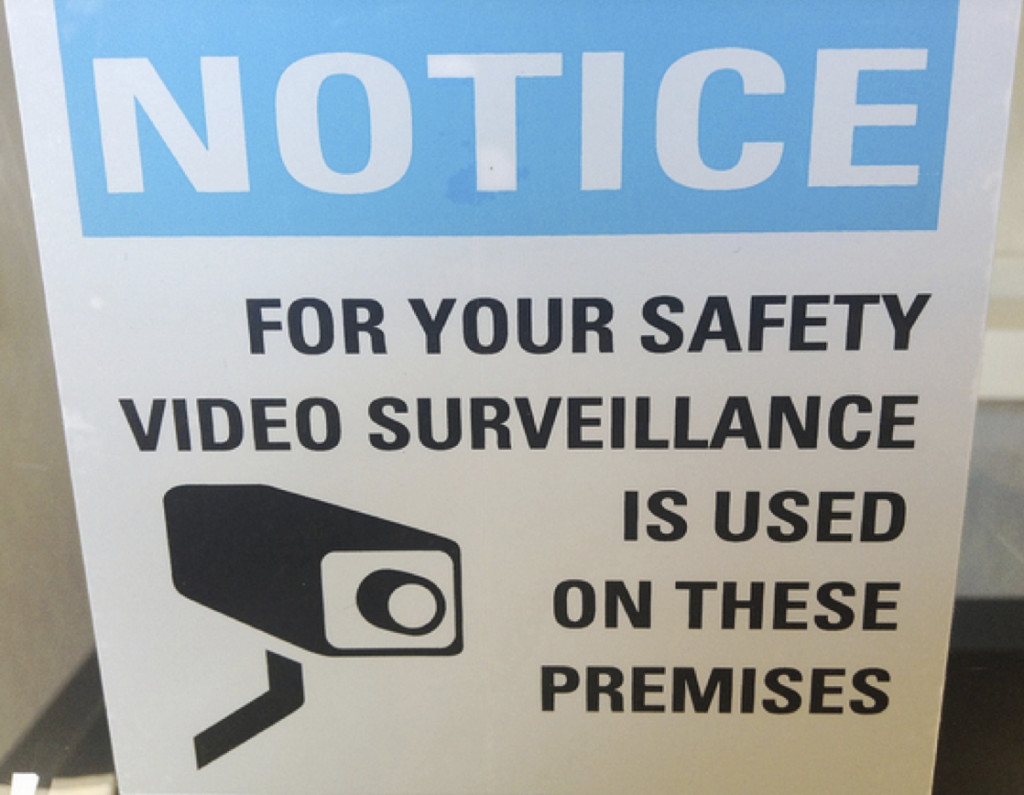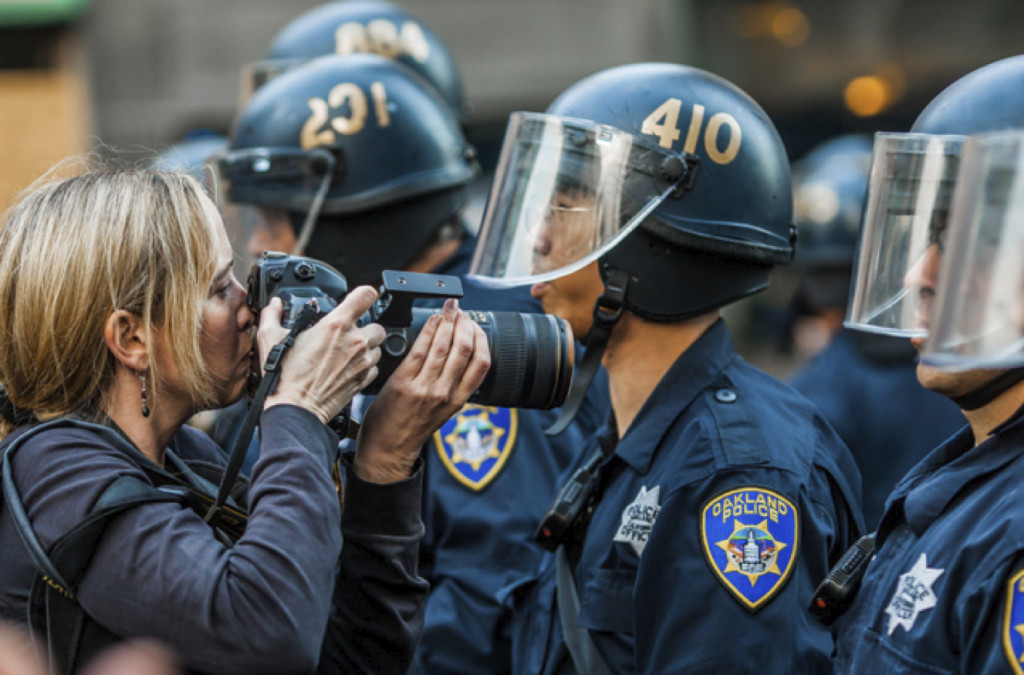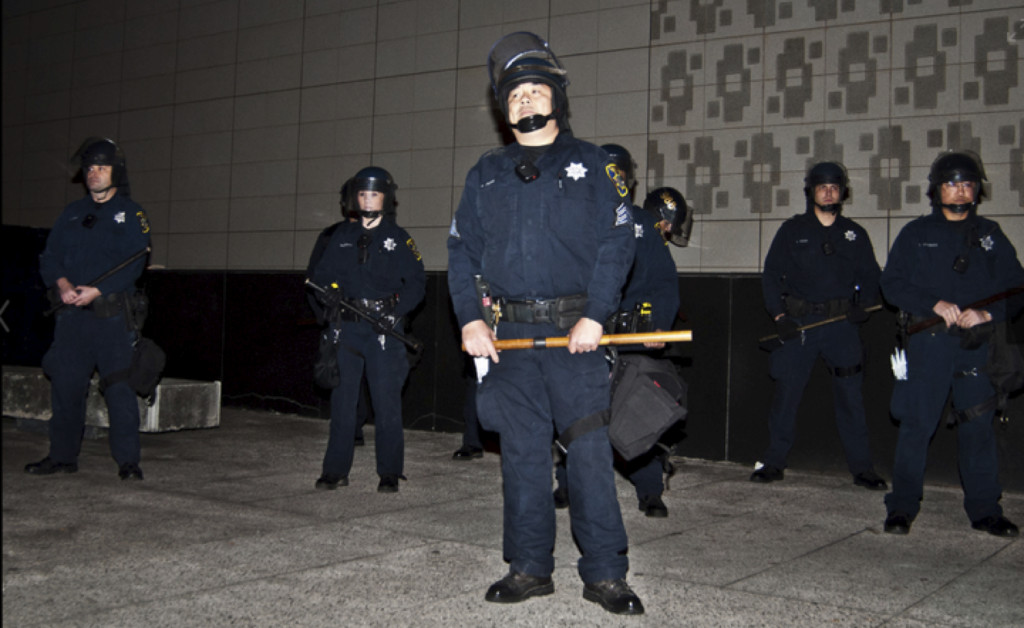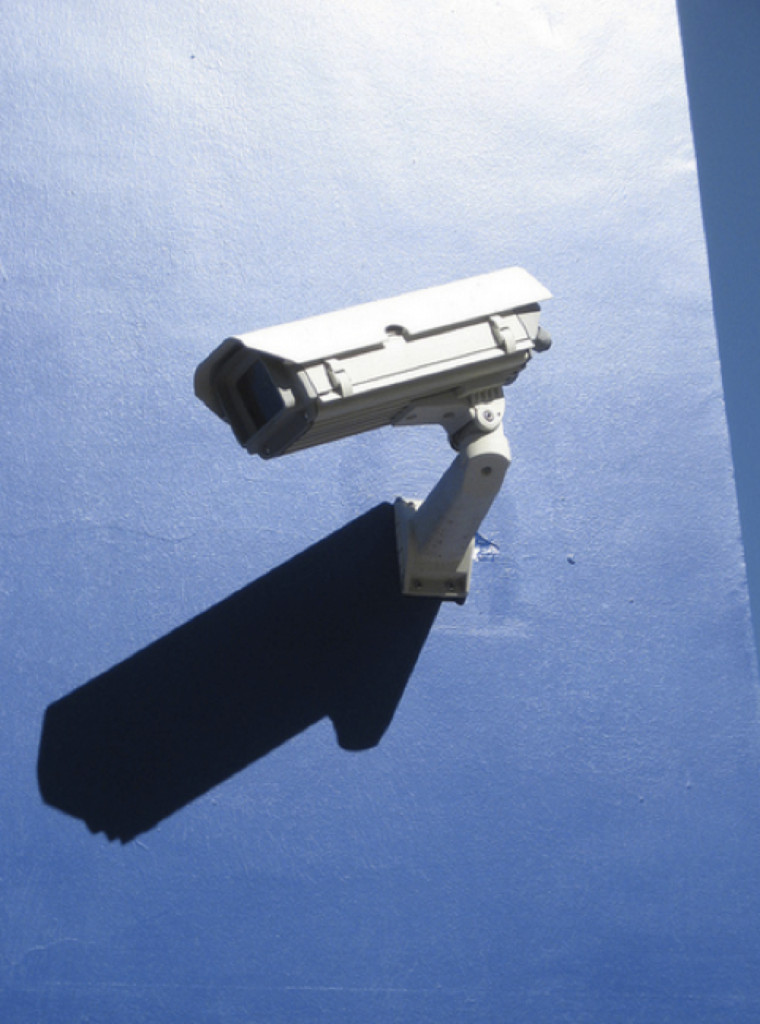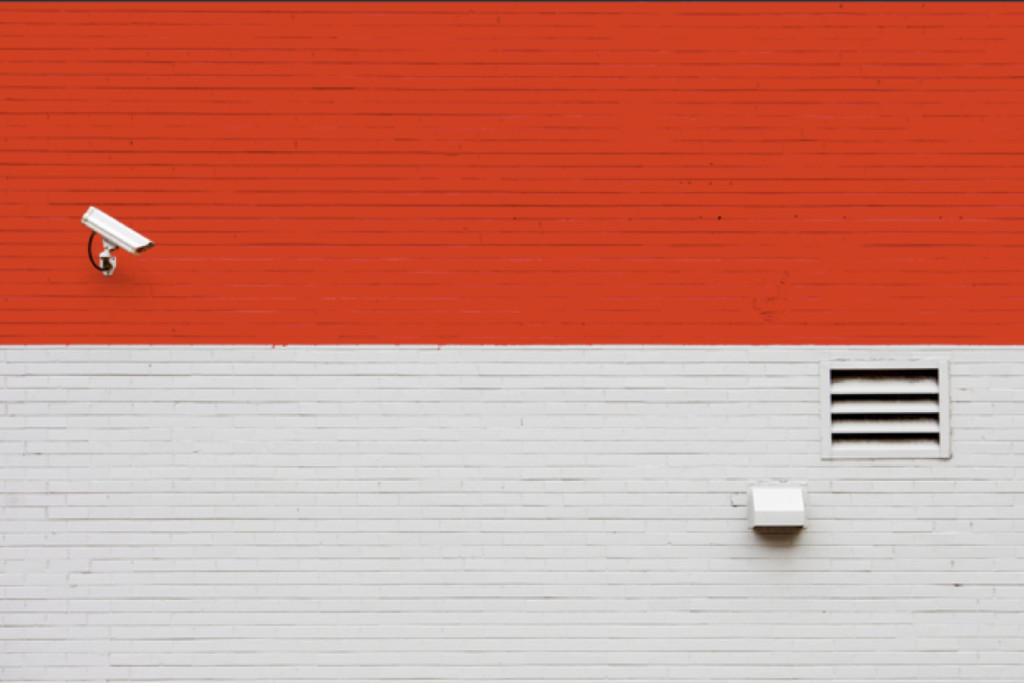
Image Credit: Thomas Hawk, via Flickr
[1]
One day this spring Annie Fougner called her college classmate Katy Abbott in a panic. Fougner was at a bank in downtown Oakland, California, wondering if she was about to get arrested.
Fougner hadn’t done anything wrong. She’d been walking around downtown, photographing every visible security camera one by one and tagging them with her smartphone, until she was stopped by a bank security guard. She said she was just mapping the publicly visible surveillance cameras for a school project. He said it was illegal, and she had to leave. When she insisted that she wasn’t breaking any laws, he told her to wait while he went upstairs to call the police. He even offered to involve “the feds.” Abbott, Fougner’s partner in the project, was surprised to get the phone call, and in light of the threat and their mutual uncertainty, the two women decided not to press the issue. Fougner opted to melt away.
Fougner’s affront to the bank’s surveillance system must have struck a nerve with the security guard, but perhaps the guard didn’t understand his own discomfort. He simply took surveillance as a given, and any interaction as an implicit threat. What he might not have known is that the City of Oakland is in a surveillance tug-of-war. From the police abuse and lingering tear-gas clouds of the Occupy movement to new, more clandestine and government-funded spying programs in the works, activists, academics, reporters, and citizens alike are fighting for Oakland’s independence from a deeply invasive surveillance hub unlike almost anything seen yet on the West coast.
Surveillance can be invasive from one angle, to be sure, and cause for public concern. But shift the camera lens (or the viewer, or subject) and surveillance presents enormous opportunity, too. Surveillance as a concept is so abstract, seemingly distant – cinematic even – that most people, even its executors, would rather not consider themselves a subject. But in certain pockets of the East Bay, certain people – from University of California, Berkeley professors to newspaper reporters and discreet, concerned citizens – are doing their best to figure out who is watching, and how to turn the cameras around.
[2]
When Big Brother moves to Oakland, his home will be the boxy gray building at Seventeenth Street and Martin Luther King Jr. Way. The building houses fire dispatch, offices for twenty different city departments including the Oakland Police Department (OPD), and what’s generally known as the Emergency Operations Center, a localized subset of the Oakland Fire Department with the general mandate to protect the city from emergency scenarios. Between the building’s steel frame, backup power systems, and interiors specially designed to mitigate stress on workers, it’s where you’d want to be if something went terribly wrong in this city.
In July 2013, the boxy grey building was slated as the headquarters for one of California’s most far-reaching surveillance programs to date: to be the recipient of a $10.9 million grant from the United States Department of Homeland Security to install a surveillance super-system called the Domain Awareness Center (DAC). Originally envisioned as an anti-terrorism tool for the Port of Oakland – the fifth biggest in the country – the 2013 city council vote paved the way for the new, federally funded DAC to blanket the whole city. It would mean high-resolution cameras on street corners, in schools, at parks, from police cruisers, audio feeds, license plate readers, and looming, mobile watchtowers that appear overnight in tough neighborhoods – all routed into one boxy grey building. And that’s just to start.
Public surveillance hubs are where the lines between emergency management and everyday police work blur, but in America’s cities, they’re nothing new. They look much like you’d imagine: somewhere between NASA Mission Control and Ed Harris’s production lair in “The Truman Show.” Promotional videos from cities all around the country advertise these centers’ key features and tout their high-effect tech. Wall-to-wall displays dominate the room. Dozens of monitors plastered with criminal records, maps, and live video flicker above rows of desks all oriented toward massive central screens. Promos for these “Real Time Crime Centers” (RTCC), from companies such as Motorola and IBM, emphasize the impact on street violence, theft and robbery above all.
And yet the potential surveillance power of the Oakland DAC is stunning. As described in an article reported by Ali Winston for the East Bay Express in 2008, dating back to an initial proposal for the project, and scores of original links and government documents posted to Oakland Wiki, the DAC is envisioned as a fully-integrated “fusion center” akin to an all-knowing, all-seeing crime-stopping force. Video pours in from several hundred public cameras – and an unstated number of private cameras furnished by merchants and other so-called “sponsors.” One chart shows how surveillance from every major Bay Area transit authority, including CalTrans, BART, and CHP, would all supplement and augment these information streams. Scores of hidden, ShotSpotter-brand microphones planted in the city’s farthest reaches deliver real-time audio feeds. The system would penetrate high volume public areas, the Oakland Unified School District, and Oakland Housing Authority residences. Dozens of license plate readers auto-collect images of every passing car. Internet and social media activity in and around the city is sourced, logged, integrated into dynamic maps and weather data using Geographic Information Systems, and overlaid on satellite images.
It’s hard to figure out when Phase 1 of the DAC began, because, back in the initial 2008 proposal, it didn’t have such a name. But by July of 2013, OPD was standing before the Oakland City Council, backed with money entirely from the Department of Homeland Security, ready to implement Phase 2. The placement of cameras and other, aforementioned infrastructure was already well on its way to completion. Phase 2 involved setting up the DAC’s software systems. For this, the city tapped defense contractor Science Applications International (SAIC)– the company that Vanity Fair called, “Washington’s $8 Billion Shadow,” “the ‘expertise’ behind the Iraq war,” and “the largest government contractor you’ve never heard of.” SAIC won the contract to build Oakland’s Domain Awareness Center uncontested by any other bidders.
The most comprehensive instance of American surveillance for the stated purpose of “crime-fighting” is the city of Chicago. Chicago has one of the largest and oldest networks of linked cameras in the United States. Reports have estimated as many as 10,000 public and private cameras, and as the American Civil Liberties Union confirmed in 2012, “In the downtown district, virtually every segment of the public way is under video surveillance.” These cameras can swivel, tilt, zoom, perform facial recognition, and keep track of individuals as they move through the city.
In an increasing number of other cities, including New York and Houston, similar centralized RTCCs have sprung up in recent years, built with technology from both Silicon Valley and established government contractors such as SAIC. And though we understand the implications of such high-tech organizations, their capabilities are still hard to fathom. Cities are variously secretive about the exact uses of their surveillance systems, rationalizing their existence on a spectrum of crime to terrorism. In the Express, Winston calls it a “migration” – the centers are setup by DHS, to win the War on Terror, and evolve to serve a disparate purpose: the war on crime.
No one argued, after 9/11, that New York City needed to beef up surveillance – even as the CIA, FBI, and NYPD instituted policies of blanket-spying on Muslim neighborhoods. In July 2007, the New York Times reported that New York City would be implementing an unprecedented new technology akin to Britain’s massive “Ring of Steel,” originally built in the 1990s to protect London against terrorist threats of its own, In other words, as the Times noted, New York was getting “a London-style surveillance system that would be the first in the United States.” In August 2008, the Lower Manhattan Security Initiative (LMSI) took effect, kicking off a plan to cover Manhattan with thousands of cameras, license plate readers, and other forms of data collection, all routed into a centralized hub—a distinctly anti-terrorism control center. To begin the process, Homeland Security pitched in $10 million, and the City of New York put in another $15 million. The project, now fully operational and estimated to have cost somewhere between $40-$90 million, extends all the way into Midtown. In 2012, the LMSI was re-branded and re-contracted when New York struck a deal with Microsoft to sell its Domain Awareness System to other city governments for a 30 percent cut. But according to a statement released by Mayor Bloomberg around the time of the sale, the rationale for such wide-ranging surveillance was slightly different. No longer was it simply about patching vulnerabilities in national security: The emphasis now, was on preventing crime.
But for other American cities, including many smaller than Oakland, the data used for determining federal national security grants was flawed in the first place. A 2006 New York Times article detailed how the National Asset Database, used by DHS to calculate potential terrorist targets and apportion grant money, was completely upside-down.The list of potential targets was skewed toward rural states such as Indiana, Wisconsin, Nebraska, and Montana. The list, of some 77,069 sites considered “Critical Assets,” included Midwestern petting zoos, ice cream shops, and flea markets; plus “1,305 casinos, 163 water parks, 159 cruise ships, 244 jails, 3,773 malls, 718 mortuaries and 571 nursing homes.” In a September 2011 television report, Rachel Maddow suggested that the quality of the database had not been significantly improved in the seven years since those findings.
***
Forget if you can, for a moment, the curious plan of grafting a surveillance model from an East Coast city of eight million to a West Coast city of 400,000– most studies show a tenuous connection between surveillance and low crime rates, hand in hand with a high potential for abuse. The ACLU report from 2012 lists just a few of the recorded abuses from such surveillance centers around the world: “Male camera operators have ogled women. Sensitive images have been improperly disclosed – like the image of a person committing suicide, which was later posted to a violent pornography website. A study from England found that camera operators targeted black civilians, substantially out of proportion to both their suspicious conduct and their presence in the population being monitored.”
Even a casual Google search will tell you that Oakland’s DAC would probably not work for its stated purpose of solving a general crime problem. Studies in the United Kingdom tracking the effect of a countrywide, 4.2 million-camera system (built to protect against the Irish Republican Army’s terrorist attacks) have showed no positive effect on crime overall: “While some of the studies analyzed did show a small reduction in crime,” according to one U.K. study, these took place in areas like parking lots where cameras were added alongside increased policing and extra lighting.” The same study concluded, “In the two cases were cameras alone were added, crime either didn’t change or actually increased.” A University of California, Berkeley study conducted in San Francisco in 2008 showed that cameras had no effect on violent crime. A study from the University of Southern California that same year concluded that public surveillance had little effect in Los Angeles. The Times article introducing New York City’s new LMSI program quoted James J. Carafano, a senior fellow for homeland security at the Heritage Foundation in Washington, lamenting all the extra work that comes with sorting through massive amounts of data, which is required for many surveillance projects: “The more hay you have, the harder it is to find the needle.”
Enter OPD – a department defined in recent years by scandal, abuse, and consistent underperformance – which by 2013 was over-eager to secure a government grant and push forward with the its own Domain Awareness Center.
Ali Winston, a freelance reporter, spent years covering the abuses of OPD, and he, along with many others, was not ready to blindly accept New York’s surveillance model in Oakland – especially if it was being run by the OPD – a police department with a scattered track record in recent years. Personally, Winston’s intensity is continuous, his stare penetrating as if eyeing bacteria in a microscope – and it comes through in his reporting.
When Phase 2 of the DAC was approved in July of 2013, Winston shifted his focus from a beat reporting OPD reform, activist movement, and criminal justice law to looking closely at the surveillance system that was about to overtake Oakland. In August of 2013, Winston and reporting partner Darwin BondGraham published a story in the East Bay Express that shed light on SAIC, the company hired to carry out at least $2 million of the DAC contract. SAIC had ties to nuclear weapons, foreign drones, and had recently settled with New York City for $500.4 million in what was likely one of the biggest municipal fraud settlements in recent memory. Then, on September 11 of last year, a dozen years after 9/11, Winston published the Express cover story shining a light on the DAC. In October 2013, Winston reported that the OPD had 659 unsolved murder cases with evidence still waiting to be analyzed in the lab. Meanwhile, 95 percent of all drug crime evidence was processed within twenty-four hours. In December, Winston and Bond Graham published another Express story that included emails between contractors and OPD directly implicating the DAC’s intended use for spying on those engaged in political, First Amendment activity, rather than just “preventing crime.” Linda Lye, an ACLU attorney for Northern California, told the reporters, “Information is always fundamentally about control.”
Through efforts like Winston’s and others within a newly formed Oakland Privacy Working Group, the DAC took a hit. In March 2014, Oakland Mayor Jean Quan broke a tie between city council members in a vote to halt progress on the Domain Awareness Center. Currently its operations are limited to the Port of Oakland property – a 900-acre, 19-mile stretch of waterfront property including parts of West Oakland, Jack London Square, the Oakland International Airport, and its surrounding business park.For now the DAC only semi-exists. Its infrastructure and software are accounted for, but it sits, in the boxy grey building, unmanned.
[3]
On the particularly chaotic evening of October 25, 2011, an Iraq war veteran named Scott Olsen was critically injured when a beanbag (“lead birdshot wrapped in cloth”) fired from a rifle by an OPD officer struck him in the head, after which he was struck by a flashbang grenade. It was a crucial moment for Occupy Oakland; video of Olsen’s body went viral, and a week later demonstrators mobilized to shut down the Port of Oakland in protest. When Olsen emerged from a medically induced coma days later, he had permanent brain damage, but no answers about what had happened.
The officer who had fired the shot was unknown. At the time, no one even knew what had hit Olsen. Winston was there, filming Olsen as he was carried away. His voice can be heard from behind the camera, yelling for a medic.
That winter, Winston and one of Olsen’s attorneys’ investigators, Jacob Crawford, spent about eighty hours pouring over video from that night. But there were no clear answers. Crucial details were spread out across different cameras, different angles. One frame showed the chevron on the unknown officer’s uniform; another frame showed half of his helmet number; still only other angles could identify his movements, as he faded back, rifle on one arm, to lob a flashbang at Olsen’s body. Without an ID on the offending cop, there were no consequences. Finally, in February of 2012, Winston published the findings: They could say with confidence, after dozens of hours with video footage and police records, that it was officer Rob Roche of the OPD’s tactical “Tango Team.” A month later the City of Oakland agreed to pay Olsen $4.5 million.
Sousveillance, also known as counter-surveillance, could not be better exemplified than through Occupy Oakland. The events of the East Bay Area during Occupy comprised one of the most intimately documented American protests to date – and one of the most public instances of American counter-surveillance efforts. Remember Pepper Spraying Cop? That was more than just a meme.
It was 2011, and smartphone use had reached a critical mass. As Occupy came to a head, the streets of Oakland became only more dangerous and volatile. Diehard indie reporters and folks with nothing better to do ran through the streets of downtown Oakland, uploading video live to the web. The details they captured were startling: peaceful protestors slammed to the ground by riot police, inoculated with teargas, and disengaged by beanbags shot from rifles. Protestors retaliated with makeshift projectiles; vandals and opportunists capitalized on the confusion, smashing windows and creating new graffiti. At UC Berkeley, students watched as English professor Celeste Langan was dragged by her hair across the steps of Sproul Hall; students were arrested en masse. At the University of California, Davis, dozens of horrified demonstrators stood by, helpless, as UCPD Lieutenant John Pike casually, famously, unleashed a canister of bright-orange pepper spray into a small, immobile group of cowering college students.
In fact, there was so much video piling up, the prospect of organizing it became increasingly daunting. But to a generation of young people who spent most of their camera-time taking selfies and food Instagrams, suddenly the concept of counter-surveillance clicked.
The idea of “sousveillance” was coined by Steve Mann, the self-proclaimed “first cyborg” and Canadian inventor who is widely considered the father of wearable computing. An un-ironic proponent of civil liberties and privacy rights, Mann has invented a host of technologies, the most notable being the EyeTap, or – as he’s been calling it for decades – glass. Sousveillance, which is also called inverse-surveillance or counter-surveillance, takes the French pronoun sur (“on”) and replaces it with sous (“under” or “beneath”). It is, simply, to watch the watchers. And according to Mann’s theories, sousveillance and surveillance are like yin and yang. Mann’s EyeTap glass, which makes him look quite like Geordi La Forge from “Star Trek,” has been permanently mounted on his face – even wired into his brain – for more than three decades. Mann has endless stories about how the technology has enhanced his life – and at times, caused him to undergo harsh scrutiny – not least of all to have a record of injustices as they arise. With his EyeTap, he’s been able to do everything from document assailants to help solve hit-and-run car accidents. He patented the global high-dynamic-range imaging method for digital photography – the technology behind that little “HDR” button on your iPhone camera – which allows you to take extra-crisp composite photos. That kind of image, combining the best parts of different images into a comprehensive composite, is largely the concept behind his glass technology. Using this sort of composite-driven, “mediated”reality, Mann is obsessed with maximizing the human-vision system.
Up in the hills of Berkeley, just a few miles north of Oakland, a tool is being developed specifically intended to take advantage of composite visuals in the same vein as Mann’s “souveillance.” The Rashomon Project, run by the Center for Information Technology Research in the Interest of Society (CITRIS), is a cross-campus effort to create an open source tool for looking at public crimes and injustices from every angle. With the precept that nearly every major public event is now documented by video, Rashomon is an attempt to turn events such as the Davis pepper spray incident – or the raid on Taksim Square in Turkey, the Boston bombings, or any other disputed public event for that matter – and unite every video angle into one continuous, composite product along a master timeline. Eventually, Rashomon has hopes of using technology similar to that used in Google Street View to create a 3-D, moving environment that recreates such controversial and historic events. The end goal is, ironically, to combat the “Rashomon effect,” a nod to the 1950 Akira Kurosawa film in which different characters share conflicting perspectives on a murder.
Rashomon has been slow to catch on. As CITRIS deputy director Camille Crittenden told me, despite the proliferation of video material, activist groups are tough to pin down and organize, especially on the eve of such significant events. What is in theory Rashomon’s strength – its decentralized sourcing – is also its weakness. And without millions of dollars from Homeland Security and an military-grade, industrial tech firm contract on its side, Rashomon can’t benefit from the capabilities of real-time surveillance centers and high-yield information banks.
Moreover, without gun blasts, gas clouds, and shrapnel at their front doors, citizens are less likely to volunteer their time for such a project. Would-be sousveillors are largely defensive, and if they don’t feel like they’re under attack, they tend to put down their tools. That is, by contrast, exactly what surveillance excels at: making you forget to defend yourself, or, like the bank security guard who threatened Annie Fougner, making you assume it’s a public utility that should be fiercely protected.
[4]
Fougner and Abbott’s project had me intrigued. The members of “ICU Oakland”– an apparently loose affiliation with no acronymic explanation under which the students’ findings were published – were nearly impossible to track down or even identify. It was unclear how their map, which pinpointed as many as two hundred security cameras in the downtown area, was going to be used, if at all. Most of all, I just wanted to figure out what had inspired them to do it.
But considering how much time they spent leering at security cameras this year, Abbott and Fougner were remarkably hard to track down too. Fougner declined an interview, and after I met Abbott only once, she dropped out of contact as well. Perhaps they were practicing some prudence to which I was oblivious. Or maybe they were just shy.
When I finally did meet Abbott, I was surprised to find out that she was a teenager, just finishing her freshman year at UC Berkeley. She’d grown up in Palo Alto, amidst a generation of kids sandwiched between two tech booms. She was the kind of student who liked a challenge, and in the activity and the opportunity of the East Bay’s streets, she found an environment where she thrived. If she had her way, she told me, she’d never return to suburban Palo Alto.
Abbott met her partner Fougner, who grew up in Oakland, in an inter-disciplinary college class taught by four different UC Berkeley professors across the ethnic studies, law, and architecture departments. The course was called simply, “Prison.” Under instruction, they began thinking critically about what security cameras really meant. They were learning about prisons built as surveillance centers and classical surveillance concepts like the Panopticon. They were reading Angela Davis, Ansel Adams, Michel Foucault, as well as Mike Davis, whose famous essay, “Fortress L.A.,” takes on ideas like the “Destruction of Public Space,” the “Militarization of Urban Space,” and how, above all, the “post-liberal” provision of security cannibalized the city of Los Angeles, in a style that the New York Times once called “a bit much.” Surveillance in our streets, activists and thinkers such as both Angela and Mike Davis have argued, is an extension of the prison-industrial complex (PIC). So, as a final project, Abbott and Fougner decided to investigate the cells and blocks of Oakland’s surveillance system.
One of Abbott’s major inspirations for the project, she said, was Cory Doctorow’s book Little Brother, a young adult novel set in the aftermath of a terrorist attack on the San Francisco-Oakland Bay Bridge. The novel details a group of young people fighting back against new, frightening forces of manipulation – not the terrorists, but the civil rights clampdown from Homeland Security. When it was released, and hit the bestseller list under “Children’s Books” in 2008, the New York Times praised the novel, comparing it to Fahrenheit 451 and 1984. It raved, “every page is charged with an authentic sense of the personal and ethical need for a better relationship to information technology.”
Though fiction may have inspired Abbott, she is grounded in reality, and calmly educated me, sitting in a café on Berkeley’s southside, about surveillance and critical theory. She told me about the hundreds of security cameras she had mapped and made known to Oakland’s public. She recounted the stories of the people she had interviewed for the project. “We asked people what made them feel safe,” she recounted, “—prayer, family – no one said security cameras.”
And on the day that Fougner called her in a fright, they had decided that she should not stick around to test OPD’s temerity. She let the security guard win, and left without an altercation. In the end, Abbott told me, getting arrested was an inconvenience that no one needed. I chimed in again, trying to confirm that their actions were legal and justified, “—but, you were allowed to be there, right?”
Abbott chose her words carefully: “Being allowed to do something is very different than Oakland Police letting you do it.”
She pretty much had it figured out.
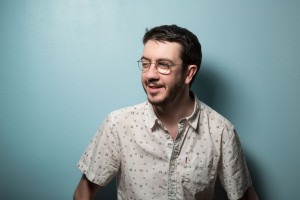 Will Butler (@willkbutler) is a journalist from California. Recently, he has written about blindness, business, and technology for the New York Times Magazine, The New Yorker, The Atlantic, and The Toast
Will Butler (@willkbutler) is a journalist from California. Recently, he has written about blindness, business, and technology for the New York Times Magazine, The New Yorker, The Atlantic, and The Toast

